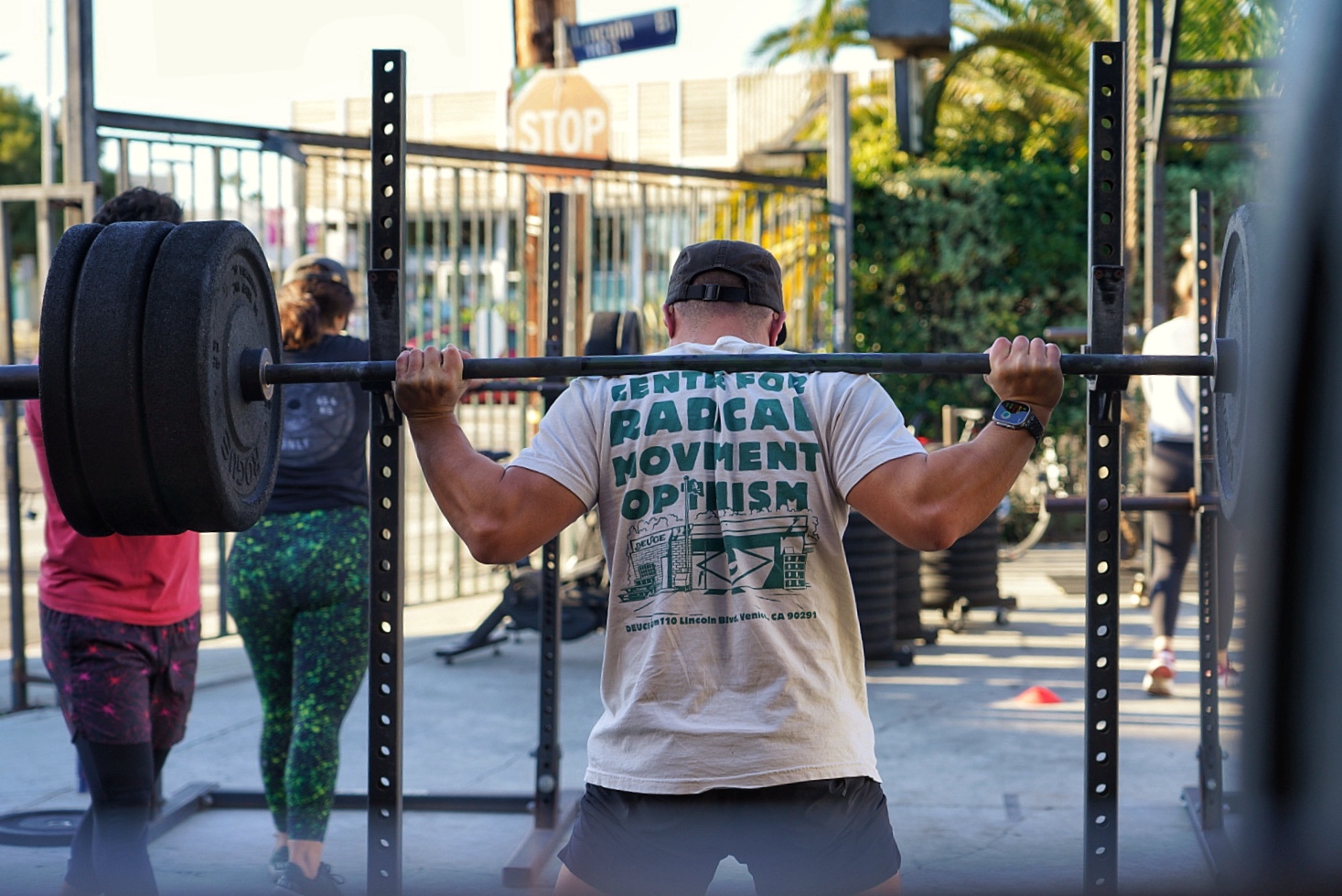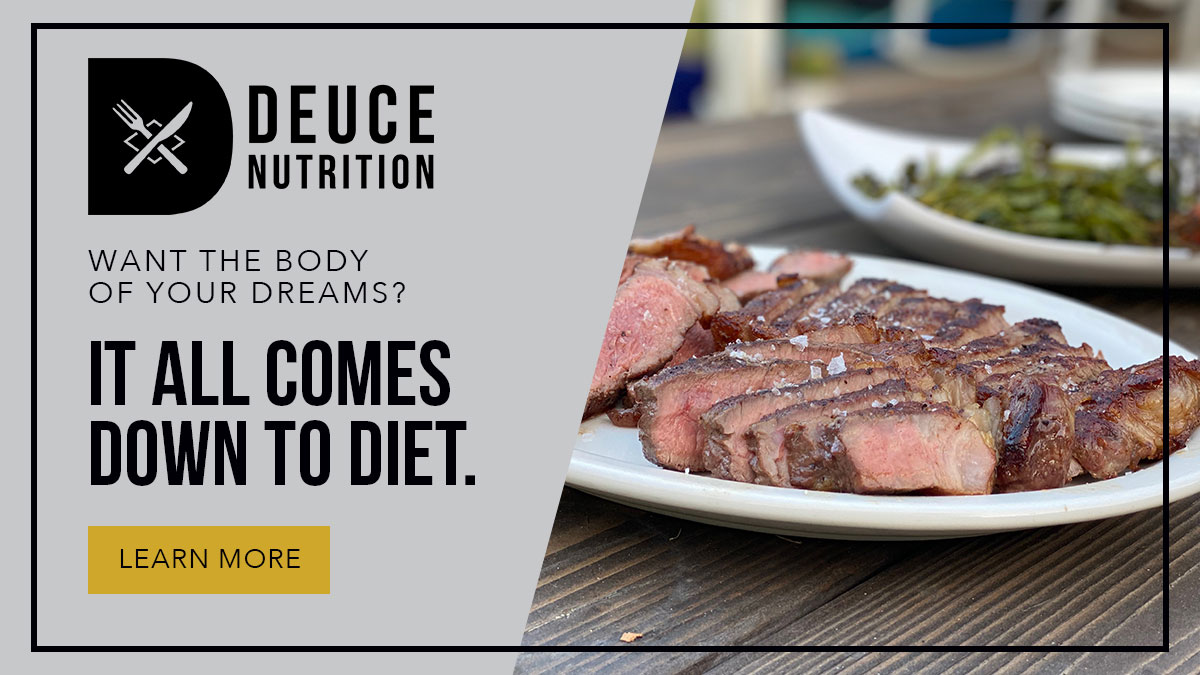
We’ve talked in Part 1 about the evolution of training from odd objects to straight bars to the introduction of specialty training bars to allow for different stimuli.
This article introduces some of the bars we have available at DEUCE so that you can be empowered to get the most out of your training and gym equipment.
Kadillac Bar
The Kabuki Kadillac Bar is one of my personal favorites. The most apparent features of the bar are its offset neutral grip handles and curved shape. The offset handles allow the athlete more opportunity to create torque in an advantageous shoulder position while bench pressing. The curvature provides for an increased range of motion, which presents more opportunity for strength and hypertrophy gains and for loading the shoulder in extension. This is particularly valuable because so much of what we do in life and sport requires our shoulder to be in a stable position behind the torso. The pendulum curvature of the bar means that the bar will always seek a neutral position. If the bar is not locked In this position, it will shake slightly attempting to find it. This serves as a cue for the lifter to set the bar and their shoulders properly.
All of that information can seem overwhelming. Don’t let it. This bar is an excellent option for those looking to improve their bench press, learn how to bench, or experience pain while benching. The bar can also effectively be used for overhead and incline pressing, row variations, and even elevated bodyweight movements like push ups.
Bamboo Bar
The Bamboo Bar was developed to increase stability in static and dynamic positions, meaning it can be utilized in isometric holds and full-range of motion lifts. When load is applied to the bar, it is attached by elastic bands. The load causes the flexible bar to oscillate, forcing the lifter to recruit stabilizer muscles to control the bar. You can substitute the Bamboo Bar for the barbell in almost any lift or positional hold, increasing stability and positional competency. This bar is a go-to for me in overhead lifts, and for deload or restorative training because it will severely limit the load I can add to a movement.
Transformer Bar
I believe that the Transformer Bar is the most valuable bar we have at DEUCE. However, many people are intimidated by it or do not understand how to use it correctly. The two primary benefits of this bar are its weight (45 lbs) which makes it accessible, and its versatility.
There are 48 different loading positions on the Transformer Bar. Loading can be manipulated horizontally and vertically via a simple cam system. Varying the position vertically can bring it closer to a Chamber bar and increase the difficulty of the movement. Varying the loading position horizontally will mimic different movement patterns on a spectrum. The various positions mimic a goblet squat, front squat, high bar squat, low bar squat, and a hinge.
The versatility of this bar allows for a highly individualized and customizable training experience. Many athletes are restricted from loading certain positions with a full range of motion due to past injuries, anthropomorphic differences, or lack of technical proficiency. A straight bar just does not allow for certain differences in individual leverages. The Transformer Bar allows everyone with these issues to get in a better position under load to drive adaptation.
Many of the positions listed above have loading restrictions. For example, in a goblet position, you can only hold so much weight in front of your body before your elbows and shoulder joints can no longer handle the strain. The goblet setting on the bar circumvents this problem by placing the load in a far anterior position so the stimulus is still achieved, but securing the bar on the shoulders so as not to limit loading. Another example of this is the low bar back squat and good morning. These movements can be highly uncomfortable or even unmanageable for many athletes with a straight bar due to the extreme degree of external rotation required at the shoulder. This bar allows those positions to be loaded with no strain on the shoulder joint.
Trap Bar
We have several Trap Bars at DEUCE, three to be exact. They are all manufactured slightly differently but serve the same purpose. Trap Bars allow us to change the deadlift’s joint angle and loading position. This can help athletes maximize their strength potential while avoiding injury and strain on the lumbar spine.
The start position of the trap bar deadlift can be manipulated by using different handles (specifically on the Rogue Trap Bar) or by pulling from either a deficit or elevated start position. Considering the loading angle and stimulus you’re looking for can help you choose the start position that best fits your needs.
In addition to deadlifts, Trap Bars are also an incredibly valuable tool for carries and plyometric training.
Axle Bar
You might recognize the Axle Bar from our Strongman Specialty course, where it is a staple in programming. Even if you have no interest In training Strongman, this bar should be a staple in your training. Utilizing it in all lifts will increase your grip strength and allow you to moderate the training load, an essential training variable to manipulate for recovery. The Axle Bar also enables us to vary the loading stimulus for different lifts in unique ways.
It will slightly alter the deadlift’s start position and increase rigidity demands in the upper back. When utilized in bench and overhead pressing, it will improve the engagement and strength of the arms, upper back, and wrists, all vital components of pressing movements.
Texas Deadlift Bar
A bar just for deadlifts!? Yes, and unless you’re a powerlifter in a federation that does not allow for these bars in competition, you should use a Deadlift Bar to get the most out of your training. We currently house one Texas Deadlift Bar on the 104 side of the gym. This bar is longer than our straight bars at 92 1/2” long with a 15 1/2” loadable sleeve and 27mm Shaft Diameter with aggressive knurling. The smaller diameter and knurling allow for a more secure bar grip. The manufacture of the bar allows for more ‘whip’ or bend in the center of the bar. This makes the bar significantly more manageable to break off the ground and allows the lifter to create more momentum off the floor. While it is true that the design of the bar will benefit sumo deadlifts more than conventional, it can and should still be used for most deadlift variations. You will NOT want to use this bar for rack pulls or other lifts besides the deadlift.
Swiss Bar- Like the Kadillac Bar, the Swiss Bar is another neutral grip bar that is primarily used for benching. It lacks the curvature of its cousin but is a phenomenal tool for taking stress off the wrists and stimulating the triceps and shoulders. This bar is great for varying the stimuli of the bench press, especially if you struggle with lockout or experience wrist or shoulder pain while benching.
Chamber Bar
Another potentially intimidating bar in our arsenal is the Chamber Bar. This bar looks a little scary because of its unique shape. However, it can be one of the friendliest bars for your shoulders because it places them in a more externally rotated position if held on the chamber.
In a squat, the lowered position of the load forces lifters to fight to avoid a forward pitch of the torso. This is an exaggeration of one of the most common faults we see in the squat. If this is an issue for you, I recommend pairing this bar with tempo to address this issue.
The Chamber Bar will cause the same instability and oscillation in lunges, good mornings, Zercher carries, and pressing variations that It will in the squat, making it a valuable tool for almost all aspects of training.
Elite FTS Yoke SSB Bar
While we house several Safety Squat Bars, the Yoke SSB Bar by Elite FTS is my favorite and the easiest to use. Any Safety Squat Bar will change how the load is distributed in the squat. The bar’s position will enable a more upright torso position, which promotes greater range of motion in the athlete’s squat. You can think of the stimulus as being somewhere between a high bar squat and a front squat. This allows for a greater stimulus on the anterior of the body (think quads and front core).
This bar is also extremely valuable for other compound movements. With Unilateral work like lunges and split squats, it not only changes the loading stimulus but also, by design, makes these movements easier and more comfortable to perform. With movements like the box squat and good morning, the SSB will challenge and reinforce upper back rigidity.
Various Straight Bars
In addition to the various specialty bars at the gym, we also have different straight bars that serve slightly different purposes.
These bars vary in weight from 15 (red tape) lbs to 35 (white tape) lbs and 45 (blue tape) lbs. The correct bar might vary according to the task at hand. We also have 45 lb bars with green tape on the side. We refer to these bars as beater bars. They have a wider diameter and are best used for squats and landmine work.
Often, students wonder what the best bars are for Olympic Lifting. The easiest way to select these bars is to look for those with a smaller diameter and whose sleeves spin more readily.
In addition, we have a York Power Bar on the 104 side that is best used for more static movements like the squat, bench press, and deadlift rather than more dynamic lifts.
If the variety seems overwhelming, rest assured that with time and repetition, you will develop a feel for what bar is most appropriate for you in a given situation.
Our goal as coaches is always to create autonomy rather than dependence in our athletes.
Our burden is education and empowerment. The student’s burden is to show up with purpose, willingness, intention, and curiosity. Consider this article a starting point and a reference for the different bars available at DEUCE. If you ever have any questions or hesitation about what tool is right for your training, don’t hesitate to consult with a Coach.
While these bars are implemented in our General Physical Preparedness program, they truly shine in our specialty course programs. These programs, available in person at our Venice location and online through Train Heroic, offer a unique and comprehensive training experience that will take your fitness journey to the next level.
6/11/24 WOD
DEUCE Athletics GPP
Complete 4 rounds of the following:
10 Front Squat
8 KB Goblet Lateral Step Ups (ea)
50 Yard DB OH Offset Carry
For Time:
Block Run
Then,
3 Rounds
10 1- Arm KB Swings (53/35)
6 KB Reverse Lunges
8 KB Push Press
Then,
Block Run
DEUCE Garage GPP
8-8-8
Inverted Alt Wall Facing Shoulder Taps (ea)
Complete 3 rounds for quality of:
3-5 Bottom Half Pullups
3-5 Top Half Pullups
Max Strict Pullups
Then, complete 3 rounds for time of:
5 Devils Presses (50/30)
25 Push Ups
50 Double Unders

